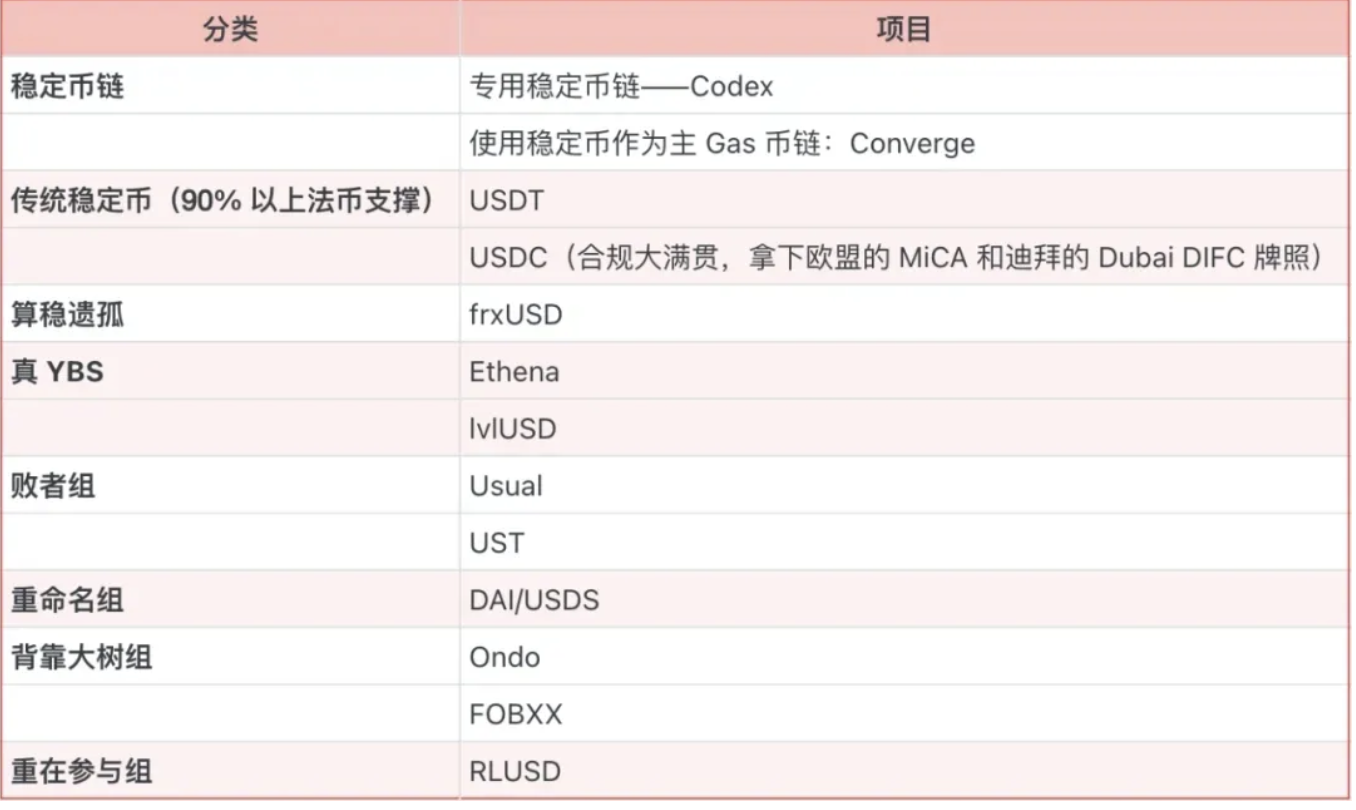The end of the US dollar seigniorage and the stablecoin super cycle
Stablecoin Supercycle
- YBS’s shift away from US bond yields, moving towards native yield generated purely on-chain — for example, through staking assets like BTC, ETH, or SOL.
- YBS “LEGO-style” compositions — Pendle is just the beginning. More DeFi protocols need to support YBS until we eventually see a fully on-chain version of USDT.
- Payment products — Technically easy to build, and the yield feature makes customer acquisition easier. However, the real challenge lies in regulatory compliance and scaling the business. Even with USDT/USDC, payments mainly function as backend settlement “middleware” rather than being directly used as a medium of exchange.
In 100 days, stocks, bonds, and currencies could all collapse simultaneously, accelerating the breakdown of fiat currency systems.
Just like the 2008 financial crisis gave birth to Bitcoin’s earliest believers, the “suicide” of fiat systems in 2025 could usher in the rise of on-chain stablecoins — especially non-USD, undercollateralized, yield-bearing stablecoins (YBS).
However, undercollateralized stablecoins are still mostly theoretical. The fallout from the Luna-UST collapse in 2022 is still lingering. Yet, due to pressure for greater capital efficiency, partially collateralized stablecoins will inevitably become mainstream in the market.
Non-USD stablecoins are still in the experimental phase. The US dollar remains widely accepted as the global reserve currency. To maintain industrial capacity and employment, China is unlikely to actively push for large-scale internationalization of the RMB, meaning the replacement of the dollar will be a very slow process.

Image Caption: Non-USD Stablecoins
Image source: https://dune.com/base_ds/international-stablecoins
Based on the above two points, this article mainly examines the latest stage of existing stablecoins, that is, the overall appearance of YBS, a USD-based, fully-reserved on-chain stablecoin system, which contains the basic appearance of post-USD, non-full-reserve stablecoins.
The internal manifestation of seigniorage is inflation, which is commonly known as internal debt, and the external manifestation is the dollar tidal cycle.
1. Trump Abandons Dollar Hegemony
From a technical point of view, the issuance of US dollars is a countermeasure between the Federal Reserve and the Ministry of Finance, which then uses the credit relationship of commercial banks to amplify the currency multiplier and create currency circulation at different statistical levels such as M0/M1/M2/M3…
Under this issuance model, U.S. debt (T-Bills, T-Notes, T-Bonds) is divided into long and short lengths to maintain the slow inflation of the U.S. dollar and the short-term currency value stability. U.S. debt interest rates become the pricing basis for the entire financial world, and the U.S. dollar becomes the world currency at the expense of the U.S.’s external deficit and countries’ dependence on the U.S. dollar.
The price has always been two-way. The only product of the United States is actually the U.S. dollar itself, and all countries in the world need to obtain U.S. dollars and realize the purchasing power of U.S. dollars.
The purchasing power of the U.S. dollar will depreciate in the long term, regardless of Trump’s will. Countries must obtain U.S. dollars to minimize transaction intermediary costs. It is not that bartering is unfeasible, but using U.S. dollars directly is more cost-effective.
The hard-earned US dollars must be spent quickly for production or financial arbitrage in order to preserve their purchasing power and maintain the competitiveness of exports to the United States in the next stage.
Now this cycle is being destroyed by Trump’s Schrödinger-style tariff system. Trump is increasing tariffs and Trump is forcing Powell to cut interest rates. Countries no longer want to hold U.S. dollars and are fleeing the U.S. bond market, making the U.S. dollar/U.S. bond a risky asset.

Image Description: U.S. dollar operation process
Image source: Pozsar
Slow inflation of the dollar allows the U.S. to extract seigniorage from other countries — but only if they are compelled to hold dollars and invest partially in Treasuries. This is the only way to reduce self-inflicted damage to the dollar.
Assume the following scenario:
• Alice is a textile worker who earns $1,000 in cash by toiling in a sweatshop;
• Bob is a U.S. bond salesman, Alice invests $100/200/200 in short-, medium-, and long-term U.S. bonds, and the remaining $500 is invested in expanding reproduction;
• Bob uses the bond purchased by Alice as collateral, adds 100x leverage, and goes to bank Cindy to lend $50,000;
• Bob spends $25,000 on a house, $20,000 on Mag7 stock, and the remaining $5,000 on Alice’s new bag.
In this cycle, Alice’s motive is to exchange labour for dollars and hedge against devaluation via production and Treasuries. Bob aims to recycle dollars and amplify the asset value of Treasuries. Cindy profits from risk-free Treasuries and transaction fees.
The danger lies in two scenarios: If Alice invests the full $1,000 in Treasuries, Bob and Cindy go naked — $500k wouldn’t even buy a loaf of bread. Secondly, if Bob’s Treasuries cannot be used as risk-free collateral to borrow dollars, Cindy loses her job, Bob can’t buy Alice’s handbag (only cheap underwear), and Alice loses her production investment.
There’s no turning back now. Once Trump abandons dollar hegemony, the seigniorage the U.S. extracts from the world will face a Luna-UST-like death spiral — albeit more gradual.
A fragmented global trade and financial system instead catalyzes the “globalization” of cryptocurrencies. Embracing central authorities creates single points of failure. Bitcoin being “Treasurised” won’t hurt Bitcoin, but crypto becoming dollarized could destroy crypto altogether.
Interestingly, in the coming economic turmoil, the ongoing battles among stablecoins will continue. In a divided world, we still need a “glue” language and cross-chain bridges. The great era of global arbitrage will inevitably appear in the form of on-chain stablecoins.
Pepe memes may entertain the masses, but degen memers might just change the world.
Now, let’s explain why.
2. Tail Wags the Dog: Stablecoins Displace Volatile Coins
Crypto market cap is “fake,” stablecoin issuance is “real.”
The $2.7 trillion crypto market cap merely gives a sense of market “size.” In contrast, the $230 billion stablecoin market is backed by real reserves — even if 60% (USDT) have questionable backing.
With DAI and USDS becoming USDC-ified, overcollateralized or fully-backed stablecoins based on on-chain assets have practically disappeared. Real reserves mean reduced capital efficiency — or a dramatically lowered money multiplier. For every $1 issued as a stablecoin, $1 buys off-chain Treasuries; on-chain, it can be re-lent at most 4x.
Compare this to BTC and ETH, which derive value “from thin air” — at $84,000 and $1,600 respectively. In dollar terms, crypto’s M0 is BTC + ETH (19.85M BTC + 120.68M ETH), M1 includes $230B stablecoins, and M2/M3 depends on leverage and lending-based YBS and DeFi ecosystems.
This representation better reflects the real state of crypto than market cap or TVL. Calculating BTC’s market cap is meaningless — you can’t fully redeem it for USDT or USD due to insufficient liquidity.
Crypto is an “inverted” market — volatile crypto assets lack sufficient fully-backed stablecoins.
YBS makes sense only in this context — it could theoretically turn volatility into stability — but this has never been realized. In fact, $230B in stablecoins must serve as the liquidity entry/exit point for a $2.7T market.
Ethena: A Compromise Attempt — a flawed replica of the U.S. bond system
From its initial issuance of $620M, Ethena’s USDe grew to $6.2B by February this year, briefly holding 3% market share — just behind USDT and USDC — becoming the most successful unbacked algorithmic stablecoin since UST.
USDe’s hedge model is simple:
APs (Authorized Participants) deposit yield-bearing assets like stETH.
Ethena opens equivalent shorts on perpetual CEXs.
Historically, longs often pay funding fees to shorts, creating arbitrage-based native revenue for Ethena.
Why not Hyperliquid? Because Perp DEXs are still derivatives of spot CEXs — Hyperliquid’s price oracle still references Binance. So USDe just trades on the most liquid CEXs.
But that’s not all — Ethena goes further in mimicking the dollar system.

Image Caption: YBS Classification and Operations
Image source: @zuoyeweb3
At first glance, Ethena appears to have a four-token system: USDe, sUSDe, ENA, and sENA. However, the core of Ethena has always been USDe alone. Its most critical use case lies beyond just “staking and yield farming”—namely, in adoption for trading and payments.
Let’s recall how the U.S. dollar functions: dollars cannot be entirely reinvested into U.S. Treasuries. The ideal setup is that a small portion flows back into the bond market while the majority remains in the hands of foreign holders. This structure maintains both the dollar’s status as a global reserve currency and its purchasing power.
At the beginning of this year, USDe offered a 9% yield, attracting around 60% of USDe to be staked as sUSDe. Fundamentally, this is a liability of the protocol. In theory, the remaining 40% of USDe would need to generate enough returns to pay 9% yields to the 60%—clearly an unsustainable model.
Therefore, the alliance between ENA and centralized exchanges (CEXs) becomes crucial. Drawing parallels to how Circle shares revenue with Coinbase and Binance for holding USDC, ENA essentially takes on the role of “bribing” asset providers (APs). As long as the whales don’t dump, everything stays intact. sENA acts as an additional layer of assurance to retain these large holders.
Given all these nested mechanisms, the most appropriate role model isn’t the U.S. dollar or USDC—but USDT. Tether earns $1.4 billion in profit, while $160 billion in risk is spread across CEXs and retail users.
Why? Because P2P transfers, spot trading pairs, USD-margined contracts, and both retail and institutional assets all require USDT as the most widely accepted trading medium. In contrast, USDe doesn’t even have spot trading pairs yet.
Of course, whether the Ethena–Pendle collaboration can reshape the DeFi ecosystem—shifting the core from lending to yield—remains to be seen. I’ll explore that in a separate article later.
3. YBS Is Essentially a Customer Acquisition Cost
Back in 2014, USDT first explored the Bitcoin ecosystem. It later partnered with Bitfinex and became entrenched in CEX trading pairs. By 2017/18, it expanded to Tron, becoming the undisputed leader in P2P use cases.
All the successors—USDC, TUSD, BUSD, FDUSD—have merely mimicked its model but never surpassed it. (A side note: Binance has an uncanny tendency to clash with stablecoins, having already “killed” several.)
Ethena, through its “incentive/bribery” mechanism, managed to capture a portion of the CEX market. Yet it hasn’t gained ground in the regulatory-compliant use cases dominated by USDC, nor has it challenged USDT’s dominance in trading and transfers.
YBS cannot penetrate trading scenarios—not in CEXs, nor in payment use cases—not off-chain either. With yield as its only appeal, DeFi remains its sole viable path forward.
Currently, YBS projects can be categorized as follows:

The yield from YBS represents a liability of the protocol—in essence, it’s a customer acquisition cost. For it to be sustainable, more users must recognize its dollar-pegged value and choose to hold it directly, rather than merely participating in the staking system.
Among the top 50 stablecoins by market capitalization, there’s a clear dividing line at the $50 million mark. Below is a list of current YBS projects and their respective APYs:

Image description: Ethereum YBS earnings
Image source: @zuoyeweb3
According to DeFiLlama data, current YBS yields on Ethereum are essentially dominated by Ethena and Pendle. This is a stark contrast to the DeFi Summer era, where returns could easily reach thousands of times the principal.
The age of windfall profits is over. A new era of low-yield structured finance has begun.
Gain and loss stem from the same source. Today, U.S. Treasuries have become the yield backbone for most YBS protocols—an inherently unstable foundation. Moreover, on-chain yields rely heavily on robust secondary market liquidity. Without enough user participation, promised returns could become the burden that crushes YBS projects.
This isn’t surprising. Usual, backed by Binance, manually adjusted its peg ratio; USDD, founded by Justin Sun, still claims to offer a 20% APY. Kids, that’s not funny. If the most successful project, USDe, has a native yield of only 4.9%, then where exactly does USDD’s 20% come from? I genuinely can’t figure it out.
A distinction must be made here: the APYs shown in the chart above are per-pool yields. They even include the base yield from LSD (liquid staking derivatives) assets, so they do not represent the native APY offered by each YBS protocol. In DeFi, the source of yield is often just the participants themselves—this has always been true.
With more and more YBS protocols emerging, it’s clear the battle is over market share. Only if the majority of users are seeking stability rather than yield can YBS maintain high returns while gradually replacing USDT in daily usage.
Otherwise, if 100% of users are yield-chasers, the yield itself disappears. Whether it’s Ethena’s funding rate arbitrage or tokenizing U.S. Treasuries, there must always be a counterparty taking on risk or loss. If everyone’s earning, then we’re just living in one massive Ponzi scheme.
4. A Few Miscellaneous Notes for Discussion
——This article skips over CDP-based models like GHO (Aave) and crvUSD (Curve), as they are unlikely to become mainstream. MakerDAO didn’t succeed in becoming an on-chain central bank, and it’s doubtful that other lending protocols will manage to do so either.
——Regarding algorithmic stablecoins such as UST and AMPL, the market has largely lost interest in these outdated models. The trend now favors real-world asset backing or leading on-chain assets.
——Pendle and Berachain, the former represents the new trend of DeFi, and the latter is the integration mechanism of public chain + YBS. This part is too important, so I will dig a hole and write it separately first;
——This article does not involve institutional issuance or adoption, off-chain payments, transactions, etc., but focuses more on the revenue sources and potential market opportunities of YBS.
——In addition, I am currently working on a visualization tool for on-chain revenue strategies. If any entrepreneurs/developers are interested, you can send a private message to chat.
Disclaimer:
This article is reproduced from [7UpDAO], the copyright belongs to the original author [@zuoyeweb3], if you have any objections to the reprint, please contact the Gate Learn team, and the team will handle it as soon as possible according to relevant procedures.
Disclaimer: The views and opinions expressed in this article represent only the author’s personal views and do not constitute any investment advice.
Other language versions of the article are translated by the Gate Learn team. The translated article may not be copied, distributed or plagiarized without mentioning Gate.com.
Related Articles

The Future of Cross-Chain Bridges: Full-Chain Interoperability Becomes Inevitable, Liquidity Bridges Will Decline

Solana Need L2s And Appchains?

Sui: How are users leveraging its speed, security, & scalability?

Navigating the Zero Knowledge Landscape

What is Tronscan and How Can You Use it in 2025?


